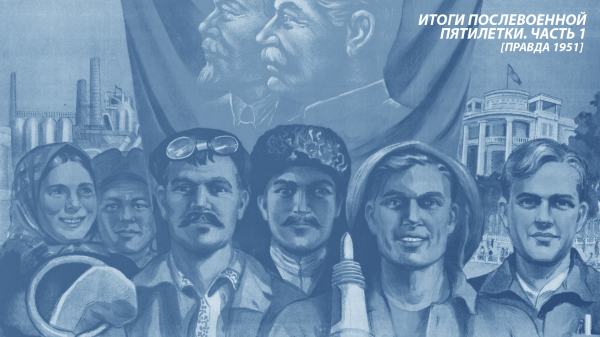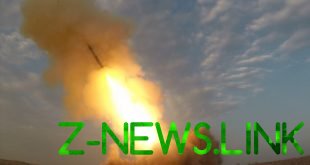
January 15, Russian President Vladimir Putin delivered a message to the Federal Assembly. Round date (2020) as if she was pushing to take stock not only last year but also in the whole five years, and maybe decades of work of the President and government. At least in his last incarnation, the President and Prime Minister are in a bundle for 8 years, and if you take the previous incarnation – that all 12.

Like a hot pie out of the oven, for such an important event from our “encoders” (those reprints, scans or video in electronic letter form) arrived article from the newspaper “Pravda” No. 107 of 1951, which summarizes the results of the first postwar five-year plan 1946-1950 But the main comparison in the article are not with the economy in 1946, when half the country was in ruins after the most terrible war in history, no. Comparisons are conducted all the statistical rules with peace in 1940, i.e. indicators and their dynamics are considered for a ten-year period.
The article of the newspaper “Pravda” editorial office is divided into two parts. In the first part we will focus on the achievements of industry, the second on agriculture, transport and communications, national income and state budget, the material and cultural standard of living in the USSR. The second part of the paper mainly concerns to those raised by the President of the Russian Federation.
Sorry, about the industry in his message Putin said as the cat laugh. Casual the President touched pharmaceutics “in the past year in some regions was irregular supply of drugs, and… people were left without crucial, often lifesaving drugs”. The solution: “centralized import into Russia of certain special drugs, …to help people, especially the parents of sick children, are no longer found themselves in a desperate situation when you need medicine it is impossible to legally get it.” Well, not to make them at home, where technology and expertise to take? And “to strengthen quality control” drugs for those enterprises that remained in Russia from the Soviet pharmaceutical industry (certainly in Russia and foreign drug manufacturers, where do without them).
The President for the umpteenth time for his term said, must “seriously ramp up investments… in the development of the industry” and so forth For this “we need to start a new investment cycle”, and it has been for several decades, the invisible hand of the market does not start. We therefore need to continue “stimulating investment”:
- “for six years not to change the tax environment for business”;
- “we need to accelerate the adoption of the package of draft laws on the protection and promotion of investments” (where more?);
- “tax conditions for large, important projects should be unchanged for up to 20 years (why not 100?), and the requirements and standards in the construction of production facilities must be fixed at three years” (will?);
- “for with Federal funds (perhaps from the profits of oligarchs?) to compensate the regions for two-thirds of their lost income from use of investment tax deduction”;
- Oh, and as icing on the cake, to burden law enforcement with proof of criminal responsibility those persons who have been convicted of embezzling public funds through a pre-organized schemes. (Who knew the President’s words about 210 article of the criminal code differently, write your version in the comments)
About the industry (heavy, chemical, light, food, timber, energy) in the message, as always, heard only promises for the future: “to create their own technologies and standards”, “to support high-tech exports” and not summed up work. A very different picture draws the newspaper “Pravda” of 70 years ago, when our country was marching to the peak of its economic power by performing accelerated pace of the postwar five-year plan.
Read the lines of the “Truth” and filled with pride for the socialist country and not experience the embarrassment of another amorphous message of the President of the bourgeois to bourgeois Parliament. (The resignation of the government and draft amendments of the current Constitution in this article remain in brackets. The President’s words taken from the Epistle 2020 – http://kremlin.ru/events/president/news/62582 )
Beskom
= = =
The results of implementing the fourth (first postwar) five-year plan of the USSR for 1946-1950
Adopted by the Supreme Soviet of the USSR in March 1946, the postwar five-year plan for the rehabilitation and development of the national economy of the USSR in 1946 – 1950, were successfully completed, and the most important tasks of the plan significantly exceeded.
THE FIVE-YEAR PLAN IN INDUSTRY
In the past five years have been major advances in the reconstruction and development of industry in the USSR. Five-year plan was established, the trade volume of the entire industry of the USSR in 1950 — the last year of the five — year plan is expected to increase by 48 percent compared to pre-war 1940. In fact, in 1950 there were industrial products made 73 percent more than in 1940. The five-year plan, executed by industry of the USSR early in 4 years and 3 months. Installed five-year plan the job in 1950 the volume of industrial production was exceeded by 17 percent. Through the introduction of the latest achievements of modern equipment is provided to further improve the technical level of all sectors of socialist industry.
Task five-year plan in the field of ferrous metallurgy in steelmaking and production of rolled exceeded. Installed five-year plan for 1950 level of production of ferrous metals is reached ahead of schedule in the third quarter of 1949, and the level of steel production in the second quarter of 1950. Completed a five-year plan for smelting iron by the Ministry of ferrous metallurgy. Production of ferrous metals as a whole in 1950, exceeded the prewar level by 45 percent when setting five-year plan by 35 percent while pig iron production increased compared to the pre-war level by 29 percent, steel production up 49 per cent and the production of rolled products – by 59 percent. The metallurgical industry of the South, was completely destroyed during the war, restored on a new technical basis and gives more metal than before the war. Continued development of ferrous metallurgy in the Eastern parts of the country. Pig iron production in the Urals has increased in 1950 compared to 1940 2.6 times, and became 2.7 times, and the production of rolled products – by 2.8 times. In Siberia the production of pig iron increased by 1.2 times, steel – by 1.7 times and rolled – 2 times. Organized the production of ferrous metals in Central Asia and Transcaucasia. Despite the over-fulfillment of plans for steel and rolled ferrous metals production and especially some of the products behind the increased needs of the national economy.
In the field of ferrous metallurgy improved production technology. In steelmaking mastered the use of oxygen. Mastered the production of special profiles and rolled steel grades for the manufacture of new types of machines and devices. Wide scale implemented mechanization of labour-consuming and heavy work and automation of production processes. Much improved hardware utilization. So, by the end of 1950, the factories of the Ministry of ferrous metallurgy the use of useful volume of blast furnaces has increased compared to 1940 by 25 percent, and will eat steel with one square meter of hearth open-hearth furnaces by 33 percent.
In the field of ferrous metallurgy and the construction of new processing factories and improve working of existing enterprises, the production of copper, aluminum, Nickel, lead, zinc and other nonferrous and rare metals significantly exceeded the prewar level. However, the growing needs of the national economy require even more rapid growth of production of nonferrous metals.
Five-year plan for coal production was exceeded. Coal production in 1950 amounted to 104 per cent in the job five-year plan and increased in comparison with pre-war levels by 57 percent. Installed five-year plan in 1950, the level of coal mining in the mines of the Ministry of coal industry will reach early in the fourth quarter of 1949. Restored coal mine in war-affected areas. Donbass mines give more coal than before the war, and more than the stipulated five-year period. Donbass is once again the largest and most mechanized coal basin countries. The production of coal in the Moscow basin increased compared to the pre-war level 3 times. Along with the restoration of the Donbass and the Moscow basin, continued the development of the coal industry in the Urals, Kuzbass, in the Karaganda basin and in other parts of the country. In the East in 1950 coal production in two times more than before the war. Greatly expanded new coal-fired base — Pechora basin. Exceeded the prewar level of production of peat.
Complete mechanization of processes of notches, cutting and delivery of coal and mechanization of underground transport and loading of coal into railroad cars. Created and introduced new machines for the mechanization of davalki coal in Stopes, as well as for loading coal and rock in the preparatory workings. Started translation work on the comprehensive mechanization of coal mines and implemented remote and automatic control of machines and mechanisms.
The task of the five-year plan for the reconstruction and development of the petroleum industry exceeded. In 1950 the oil production amounted to 107 per cent to the job five-year plan and was 22 percent more than before the war. Fully restored and re-equipped was destroyed during the war the oil industry of Maikop and Grozny oil regions and the oil industry of Western Ukraine. As a result of successful exploration identified and developed significant commercial reserves of oil and gas. Widely introduced new technology in oil production, drilling and refining. Expanded production of high-octane aviation fuel and aviamodel and improved the quality of produced petroleum products. Built new oil refineries and installations, equipped with modern domestic appliances, a large oil pipelines. However, the rapid growth of oil production requires an even more accelerated the construction of new refineries.
Greatly increased the value of the new oil regions in the East. Created major new oil fields and refineries in the Bashkir ASSR. Rapidly developing production and processing of oil in the Kuibyshev region, the Turkmen SSR, the Uzbek SSR and the Kazakh SSR. Opened large new oil fields in the Tatar ASSR. The specific weight of the Eastern regions in the total oil output of the Union has increased to 44 percent vs 12 percent in 1940.
Has further development of the gas industry. Built and put into operation a gas pipeline Saratov — Moscow and Dashava — Kiev and Kohtla-järve — Leningrad. Began the construction of enterprises for production of artificial liquid fuel.
Task five-year plan for electric power exceeded. Installed five-year plan for 1950 level of production of electric energy reached early in the fourth quarter of 1949. Electricity production in 1950 amounted to 110 percent to the job five-year plan and exceeded the 1940 level by 87 percent. In areas affected by the war, produced electricity much more than in 1940.
Rebuilt during the war of the power plant of the Donbass in Transnistria, Kiev, Kharkov, Lvov, Odessa, Nikolaev, Sevastopol, Novorossiysk, Krasnodar, Grozny, Stalingrad, Voronezh, Bryansk, Kalinina, Minsk, Vilnius, Riga, Tallinn, Petrozavodsk and other cities. Restored all hydroelectric power, including 6 large hydropower projects envisaged in the five-year plan. Restored the Dnieper hydroelectric power station named after Lenin. Built and fully operational the new power station scherbakovskaya, Niva, No. 3, Farkhad Hruska, Sukhumi, Mira, Shirokovskaya, and others. Were carried out large construction works at the Verkhne-Svirskaya, Ust-Kamenogorsk, Gumussoy, Tsimlyanskaya, Niva № 1, and others Matkozhnenskaya hydro power plants, that provides input in 1951 -1952 years. Widely deployed in the construction of the Gorky hydroelectric station on the Volga and Molotov hydroelectric station on the Kama river. Implemented construction of new thermal power plants, electric and thermal networks.
In 1946-1950 in power plants was carried out the introduction of the latest technology. In the thermal power installed turbine and high-pressure boilers of domestic production, including new types of heating in high-pressure turbines with a capacity of 25 thousand kilowatts, drum boilers at a pressure of 100 atmospheres and the steam temperature 510 degrees, as well as once-through boilers on same steam parameters. Embedded generators with water cooling, air circuit breakers of high voltage, high frequency and other modern types of protection, and automation of combustion processes and boiler feed at power stations. Two-thirds of the regional hydroelectric power plants have automatic control units.
In mechanical engineering the job of the five-year plan for the production of tools, machines, mechanisms and devices exceeded overall by 17 percent. Production engineering in 1950 exceeded 2.3 times the production of 1940. Installed five-year plan for 1950 level of production machines, equipment and devices reach early in the first quarter of 1950.
The production growth of machinery and equipment occurred on a new technical basis. In engineering plants large spread of highly efficient methods of production and technological processes: production lines and automatic lines processing, welding machines and semi-automatic submerged arc welding, hardening of parts by high frequency currents, centrifugal casting and die casting, stamping, high-speed methods of cutting metal.
Over the years, the five-year machinery industry mainly updated the range of products. Spent about 250 species of new types of machine tools for General purpose more than one thousand of special and modular machines, 23 type and semi-automatic machines, 34 type forging machines, powerful pneumatic moulding machines, machines for pressure casting and centrifugal casting. Created 26 automatic machining lines and automated production plant for automotive parts.
In 1950, the production of metallurgical equipment, increased compared to 1940 4.8-fold, production of steam turbines in 2.6 times, manufacturing of electrical equipment – 3 times. For the fuel industry produced coal combines, rock loading and coal-loading machine, oil drilling installation for drilling a deep, powerful mud pumps and many other types of efficient equipment. Production of oil equipment in 1950 increased against 1940 3 times.
For the needs of railway transport developed and organized the production of a new commodity mainline locomotives, electric locomotives, diesel locomotives, box cars, gondolas, all-metal and isothermal wagons, all-metal passenger cars.
Tractor production in 1950 increased compared to 1940 by 3.8 times, combine harvesters – by 3.6 times, tractor plows – in 3,1 times. Developed and taken into mass production more than 150 new high-performance agricultural machinery.
However, the achieved level of production of energy equipment, heavy metal cutting and forging equipment, complex of equipment for the oil industry and some types of devices do not meet the increased needs of the national economy.
In the field of chemical industry five-year plan was established to job to surpass in 1950 the prewar level of production in 1,5 times. In fact, products of the chemical industry exceeded the prewar level by 1.8 times. The prewar level of production of nitrogen fertilizers in 1950 exceeded 2.2 times and potash fertilizers is 1.4 times more than it was foreseen five-year plan. The production of phosphate fertilizers in 1950 increased compared to 1940 by 1.9 times. Increased compared to the pre-war level the production of synthetic rubber.
Greatly expanded and developed the manufacture of new products for synthetic fiber industry, plastics, for the paint, pharmaceutical and other chemical industries. Five-year plan for the production of dyes exceeded. The number of produced grades of dyes increased to 320 titles in 1950, against 186 in 1940. At the same time increased the production of high quality and durable dyes. Mastered the production of multicolor film.
Production of construction materials exceeded the prewar level. Cement production in 1950 increased compared to 1940 by 1.8 times, the window glass is 1.9 times. Task five-year plan in 1950 for the production of cement by the Ministry of construction materials industry of the USSR made at 101 percent, and in the whole Soviet Union – is 97 percent. Not fully completed task five-year plan for the production of bricks and tiles. Production of construction materials and their quality is still lagging behind the growing needs of the economy.
In the timber industry timber timber in 1950 increased against 1940 to 36 percent, but the job of the five-year plan is executed
not completely. Task five-year plan for the supply of machines and mechanisms of forest
industry exceeded, but, as a result of unsatisfactory use of the mechanisms, the growth rate of labor productivity in the logging industry during the years of the five year plan was insufficient. Paper production in 1950 increased compared to 1940 by 47 percent.
In the period 1946-1950 years have seen rapid recovery and development of the textile, sewing, knitwear, footwear and other light industries. In 1950, the products of these industries increased compared to 1940 by 17 percent. Production of main products of light industry have increased over the five years: for cotton fabrics — 2.4 times, woolen fabrics – 2.9 times, hosiery — in 5.2 times, leather footwear — by 3.2 times, of rubber footwear in 7 times is a five-year plan for the development of cotton textiles and shoes missed. Significantly improved and extended range of fabrics, garments, knitwear and shoes.
Production of main products of food industry has grown over five years on a significant scale. In 1950 the prewar level of production of butter exceeded 57 percent, vegetable oils and other fats — 10 per cent, meat by 7%, fish catch by 27 percent, production of sausage products — 20 percent, canned food by 48 percent, sugar — by 17 percent, confectionery products — by 23 percent, and soap by 16 percent. Extended range and improved quality of food products. In 1950, the production of higher grades was 75 per cent of the total butter production and 42 percent of cheese production. Manufacture of dietary products increased compared to the pre-war level 5 times, baby products – 5.7 km razaa, vitamins – 10.4 times.
Local industry and trade cooperation has ramped up production in 1950 compared to the pre-war level by 1.5 times. However, still insufficiently used local raw materials to increase production of consumer goods. The range and quality of products of local industry and fishing cooperatives lag behind the increased requirements of the population.
The basic production assets of the entire industry of the USSR in the recovery, construction and reconstruction of enterprises, equipped with advanced domestic appliances, increased in 1950 compared to 1940 to 58 percent. While the machinery due to the addition of new, more productive machines has increased by the end of the five years, more than two times compared with 1940. The work of electric power industry for calculating per worker increased in 1950 compared to 1940 in the half.
The successful introduction of new technology has allowed large scale to further technical re-equipment of the national economy and increase the level of mechanization of labour-consuming and heavy work. Along with this, technical progress, improvement of professional skills and creative initiative of workers, engineers and technicians has provided significant productivity growth. Labor productivity in industry increased in 1950 against the pre-war 1940 to 37 percent instead of 36 percent set five-year plan. Productivity in construction in the 1950’s exceeded the 1940 level by 23 percent.
As a result of better use of equipment in the industry, more economical use of raw materials, fuel and electricity, reducing losses and waste of materials, increasing labor productivity, accelerating the turnover of working capital made set five-year plan in 1950, the task of reducing the cost of industrial products.
Not fully completed task five-year plan to reduce the cost of construction. The cost of construction, despite the significant increase in capital works is still high. In this regard, the Government in 1950, measures taken to reduce the cost of construction and improve the design, increase production of construction materials, as well as deficiencies in planning and procurement of capital construction.
To be continued…
The state planning Committee of the USSR,
The Central statistical administration of the USSR
© 2020, paradox. All rights reserved.





